Creative Take on Damask Motifs
This week, we look at damask motifs from a new perspective. I challenge you to make this traditional motif your own and use it in your art!

It all started from a dream I saw a few days ago. “You should wear more decorative clothes, Paivi,” I was telling myself. “Like the old historical dress that you had at a ball as a teenager.”
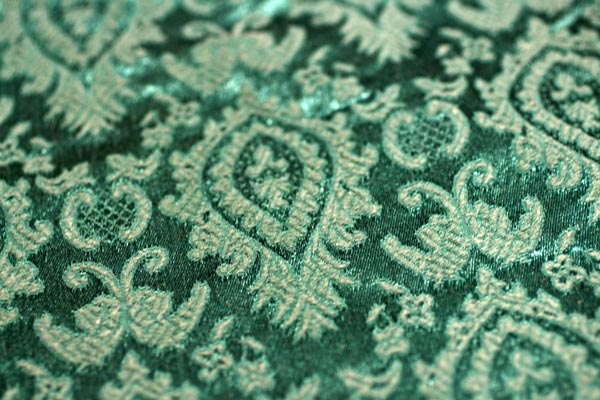
I still have the dress. It has damask motifs – woven ornamental patterns that seem to never go out of date (more about their history). The idea of perfecting not only the actual swirls but also the shapes between is a good drawing practice that doesn’t have to be boring at all!
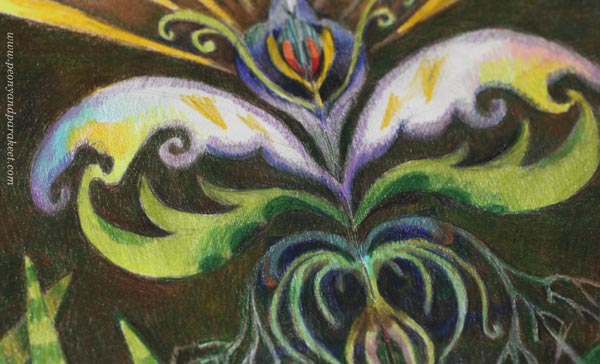
This week, I played with colored pencils mostly, but in 2015, I made a mixed media piece called Rococo. So check out this post too!

Damask Lady
The reason for my dream was an unfinished page in my colored pencil journal. I had started it at the end of last year but found it terribly uninspiring. I didn’t feel any connection with the figure, and she looked like someone had forced her to be there. In a way, that had happened. After a series of big paintings, I was knackered, as readers from the UK and Australia would describe. I had no motivation to take a brush and only a little to do something with colored pencils.
First, I added a bit of watercolor to cover white and then colored intuitively without any predefined ideas or models.
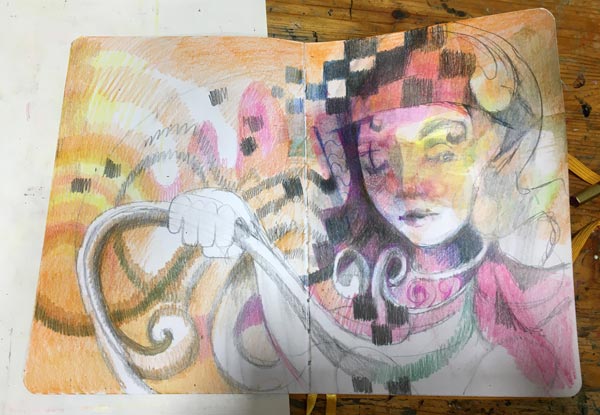
Sometimes it’s just that when you are tired, it’s best to leave the piece and come back later, even if it would be a tiny spread in a small journal. After the dream, I knew what to do: play with damask motifs!

I feel drawn to this damask lady. She looks both curious and self-confident – everything I would like to be in this new year!
Looser Damask Motifs – Nature
I got so inspired by coloring the swirly lady that the next spread was born quickly. Again, first some watercolor splashes, and then details with colored pencils.
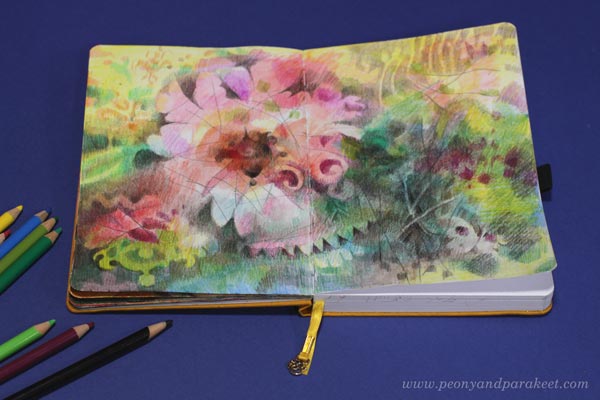
If you compare the flowery spread above with the portrait below, you see the change in looseness. The flower is much freer than the lady, but I like both. I like how damask motifs can be seen as a part of nature – snow on trees, water drops, butterfly wings and their spots. But I also like how they can be more architecture- and design-related and a part of human fantasies and mysteries.
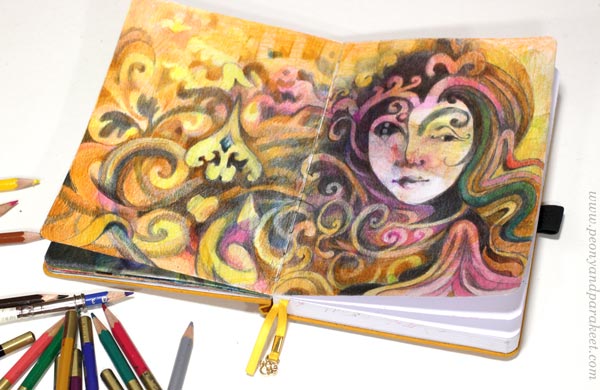
Which take do YOU like more?
Sketching a Damask Motif
Next, I wanted to go even further in stiffening the expression. I would design a damask-inspired motif so that there would be no looseness at all.
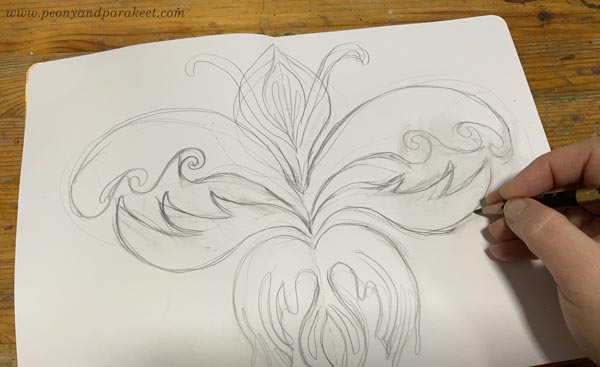
I started by sketching the motif in the middle of the spread, using the fold as a guide to achieving the required symmetry. In damask motifs, the negative – the shape of the background – is as important as the positive is. So after the careless sketch, I then went through the surrounding area and adjusted its swirls.
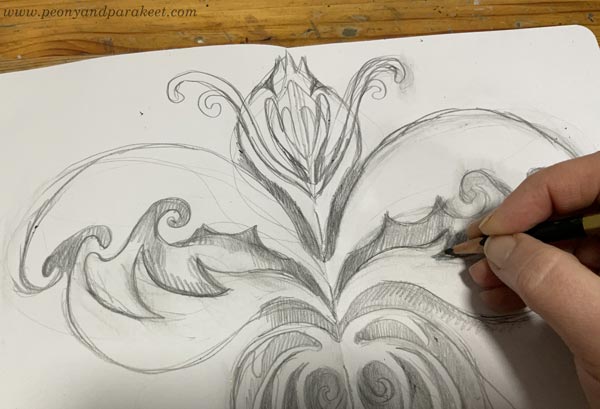
This motif felt like a forbidden fruit. I was surprised to hear myself saying: “You have crossed the line now, Paivi. Even if you always paint the inside, now it will be reverse – illustrating the outside world.” I didn’t get this first at all – I thought I was just drawing was a simple flowery ornament inspired by damask motifs!
But when I was making the finishing touches, I realized that my drawing did illustrate the outside world – our living room: a wooden ceiling, windows on the left, a wall rug on the right, a vanda orchid hanging without a pot, and the snake plants growing lower.
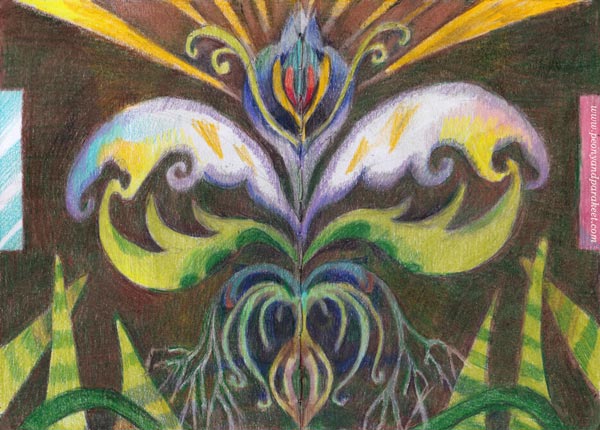
Here’s a picture of my vanda when it was blooming in 2020!
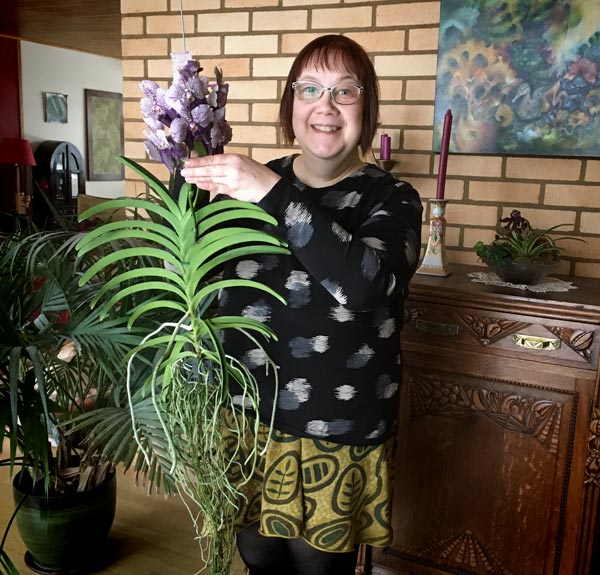
This spread is not loosely made at all, and yet I find that the looseness is how I unconsciously picked and interpreted the subject.
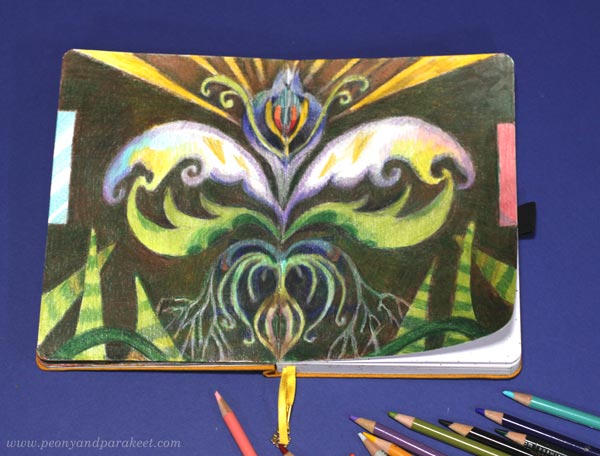
Which of the pieces of this post inspire you the most?
Are you inspired by the stiffness or looseness?
How do you want your damasks to look?
Please leave a comment! It would be so interesting to know!
Messy Art Journal Style with Colored Pencils
This week, we go deep into the messy art journal style. See how to mimic messy mixed media pages in colored pencils!
I wanted to add some happy freedom to my colored pencil diary. So here are the most recent spreads!

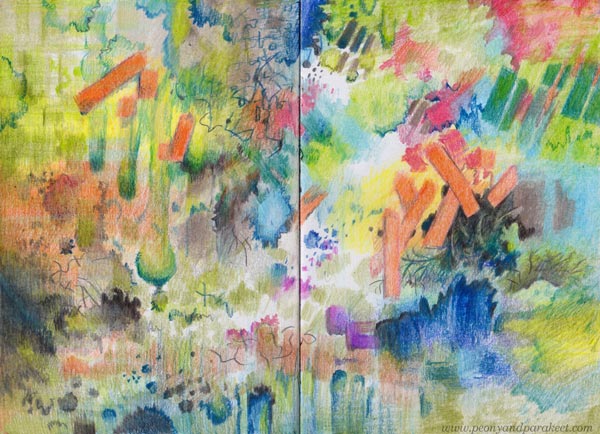
These spreads have an impression of a messy mixed media look – collage, paints, and all – but they have been made with colored pencils only.
Confessions from a Former Art Journal Book Junkie
Let’s first turn back time over ten years when my best hobby was art journaling. My day job took a lot of time, so buying became a part of self-expression. I bought almost every possible book about art journaling and dreamed about becoming a mixed media artist.
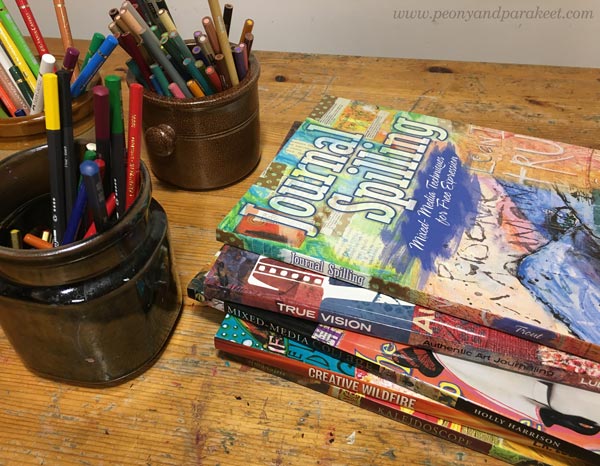
Now when I look at these books, their examples look clumsy, sometimes even ugly. But I still get attracted by the easiness that made me buy the books: “Messy is ok, you can do it!” And so did I: mixed paints, pens, collage, and all the possible media into one spread. “Mixed media techniques” was the word that I was looking for when browsing a book store or Youtube.
Art Journals Started a Journey
These journals were all the art that I created for a long time. Like the books stated, I assumed that the messy pages would be enough to define me as an artist. In some ways, I was right. A messy art journal style was a ticket to the world of art-making, blogging, even teaching. For example, in Collageland, I use paints, pens, and scissors to create fun and messy pages.
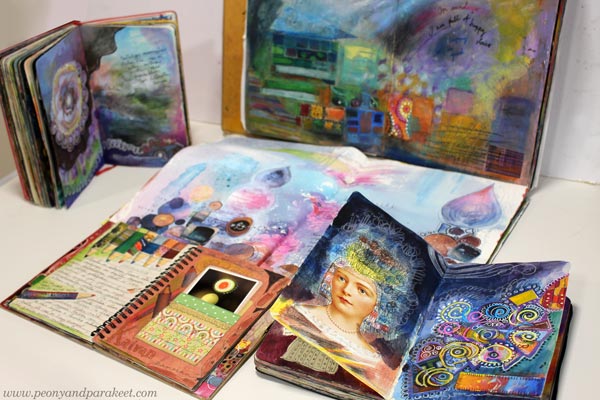
But in 2013, when I was in a local art supply store and proudly presented one of the journals to the owner, his fake smile told me that I hadn’t even started yet. In the traditional side of art-making, that is!
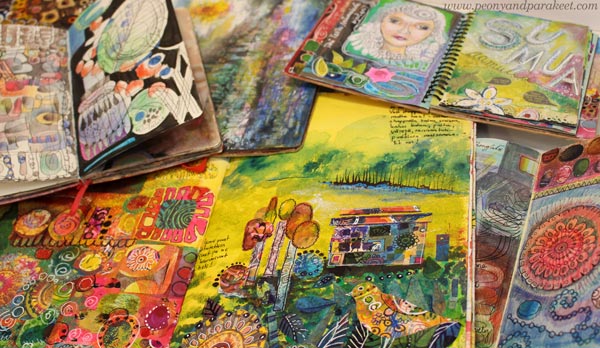
Nowadays, I think of myself being a traditional artist rather than a mixed media crafter. I prefer to stick with one medium at a time and my main artworks are more on the traditional side. And I wince every time when someone calls me a mixed media artist!
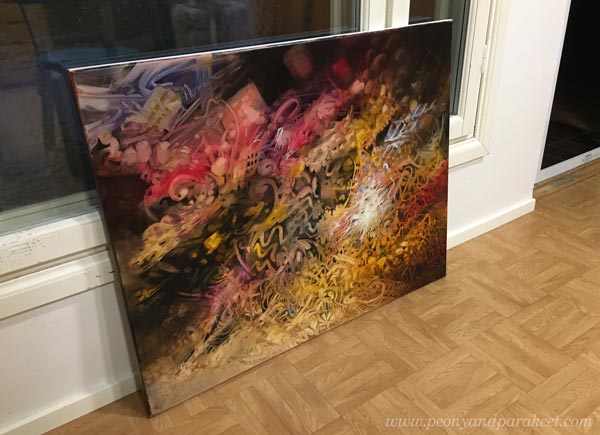
But art journaling has led me to so many happy places that I don’t ever want to get too far from it. Often, I have just replaced images from magazines with my own hand drawings.
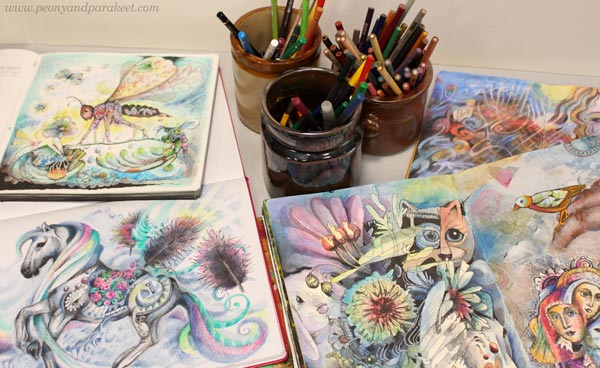
So, instead of collecting products, I can be the product. My most popular classes like Animal Inkdom and Magical Inkdom have started on that idea.
Choosing the Shortest Pencils
The best thing that I have learned from art journaling is to not over-think and just start creating. It often feels like my hand knows more than my brain. So, when I want to think further and forward, I say to my shortest pencils: “Let’s create something messy, like in the old times!”. And these little pensioners are always willing to get back to work and do what’s expected.
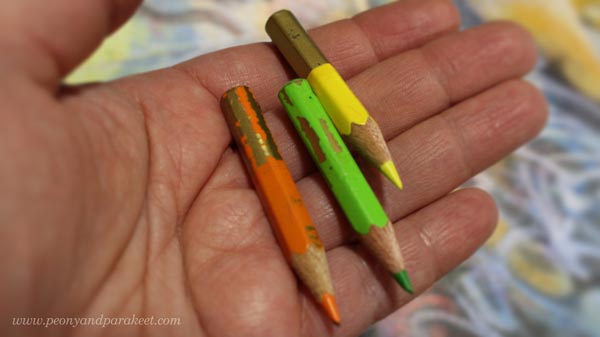
Using old and much-used pencils also takes off the pressure of pursuing brilliancy right from the beginning. For example, before I started building the class Intuitive Coloring, preliminary pieces were made with the shorties, and then for the actual recordings, I picked longer and more prestigious pencils.
So, when coloring a mess, do it with a small and diverse set of retired pencils that no longer care if you are a true artist or not!
Collage Imitation in Messy Art Journal Style
On the first spread, I mimicked what we used to include in our messy art journals: paper scraps, geometric stencils, scribbling, simple marks like x’s and o’s, flowers, and curves.

Just keep layering until the paper is covered, and don’t forget to mimic the glue too! Make the elements go on top of each other, or erase a part of them to make everything look integrated.
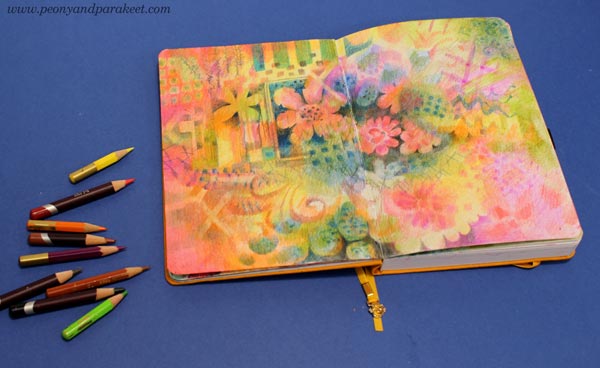
Look at my little pencils! Aren’t they endearing? I have started to carry them in a pencil case so that they are always with me, ready to be pampered.
Paint Imitation in Messy Art Journal Style
Then let’s change the mindset a bit and move from mimicking products to imitating paints. Start with stripes and small splotches and slowly grow them so that they cover more of the blank page.
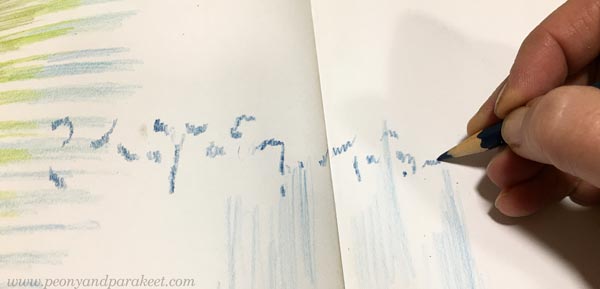
When we make a mess with paints, the edges are jagged, so color freely and intentionally make errors on the shapes.
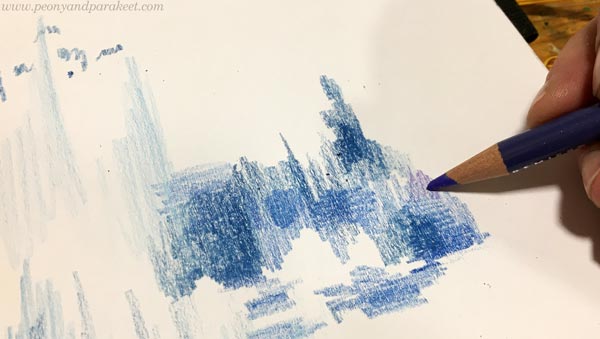
My orange rectangles represent a product, a stencil maybe, but most of the elements are more like watercolor, acrylics, or inks.
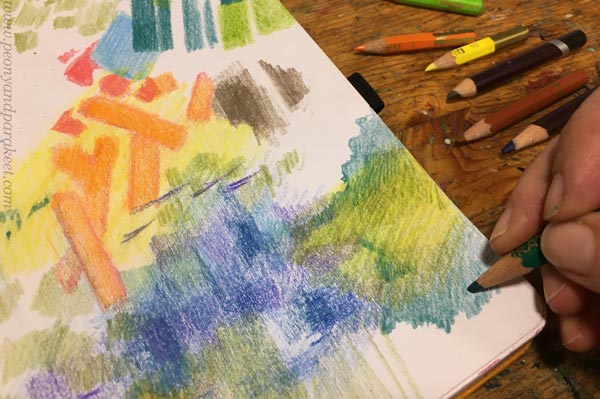
Watercolor spots have dark edges that softly fade away. By adding more colors, you can make the spots look translucent.
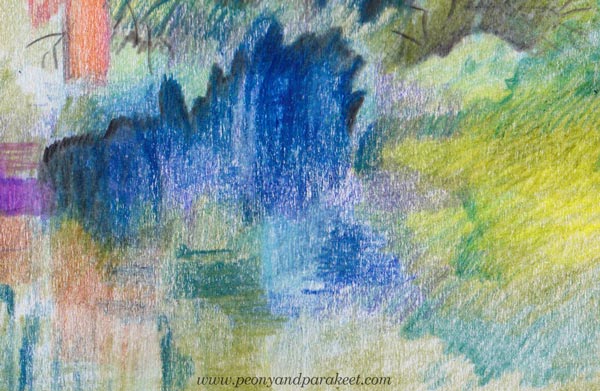
Acrylic paint has wider shadows, reflections of light (stripes and spots), and less transparency.
Add tiny spots too and make sure that their patterning is irregular.
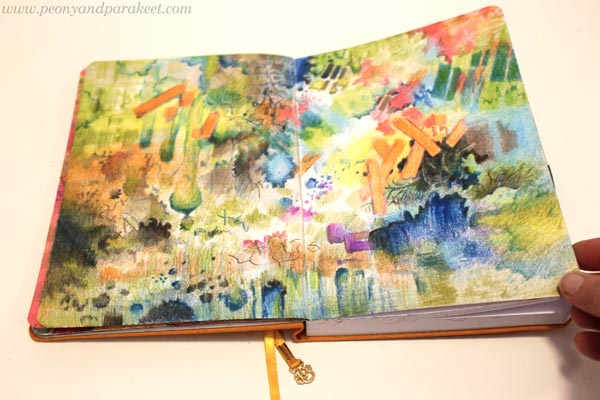
Drawing all kinds of splashes and drops was so much fun that I am now thinking: could I imitate watercolor in oils. Doesn’t this prove that mess-making and traditional fine art are not so far away from each other after all?
I hope this inspired you to pick your pencils and start faux mixed media with them!
Art is a Lemon Tree – How’s Your Lemonade?
This week, I talk about art and lemonade and share some news about the rest of the year!
I was going to make a cheerful spread on my colored pencil diary, celebrating a beginning of a period that I have never experienced so far in my life. But I started the drawing intuitively, and here’s what came up: a murky image with a bittersweet impression!

“When life gives you lemons, make lemonade,” they say.
I have never been fond of that kind of forced optimism, but I guess there’s also a seed of truth. In art, you have to make most of what you have.
What Kinds of Lemons Does the Tree Produce?
In 2014, when I became a full-time artist, I thought about growing my skills and how that would naturally lead to something good. But nowadays, my leap has felt more like changing a long CV in technology and service design to a very short, almost non-existent, CV in art.
Art is like a lemon tree. You can nurture it, but you can’t change its variety. Over the years, I have learned not only to teach but also to illustrate, make surface designs, and even draw ornaments and logos. But my heart has always been in fine art, and especially in intuitive abstracts.
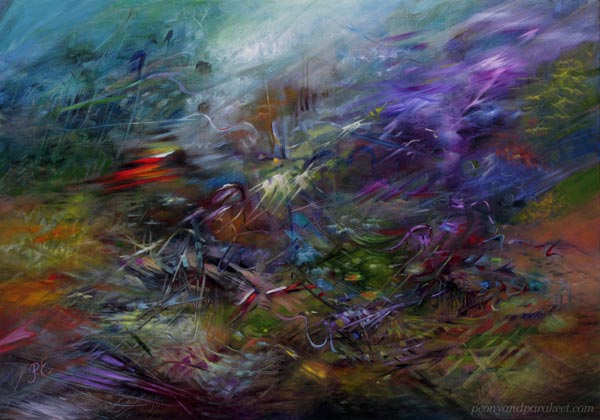
In my opinion, fine art makes the best lemons. But the weather is harsh, and the harvest becomes too small to be enough for the lemonade. So my passion for teaching has often been the lemonade maker, not the actual paintings.

But now, things change for a few months. I have got a grant from The Arts Promotion Centre Finland to create a series of paintings and write about the process. I will publish the art and most of the writings here in my blog, so you will also get to drink this lemonade!
The project has a set theme that also includes a background study. I will also continue the colored pencil diary and document a part of the process in colored pencils. Later posts will reveal more.
I hope that my project will also inspire you to create – grow more lemons and make your kind of lemonade!
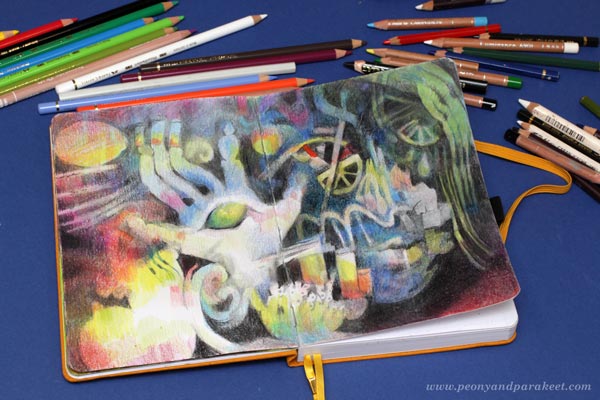
P.S. You can still sign up for Intuitive Coloring! You will get the published lessons immediately after signing up, and can start having fun right away. >> Sign Up Now!
Life in a Colored Pencil Diary
Recently, my life has not been a life of a middle-aged woman, but of a female tiger. With a new puppy, we have tried to find a balance in the family, and it has felt like a fight sometimes.

At some point in every evening, I become exhausted and demand my herd to calm down. It’s usually 21:34 exactly, so it seems that we run an accurate schedule.

But there’s not much else accurate in our life, because the puppy requires us – like my husband kindly puts it – to go with the flow. We are not talking about a flow state here, but a flow of random things that keep the puppy either awake or asleep.

I feel that the puppy is like a peacock which my husband, I, and our older beagle Stella stare at – the central character of our zoo who makes us happy or miserable, and often both at the same time.
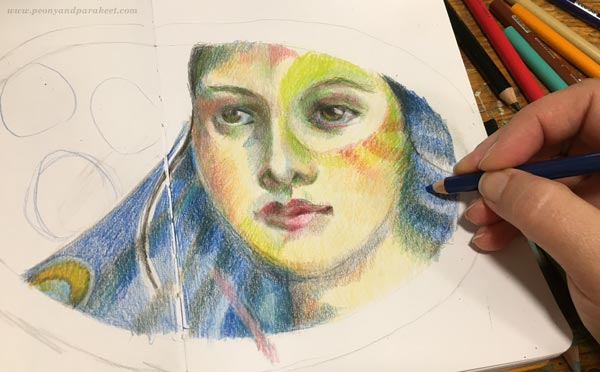
We have had stress. Stella got ill and my oldest budgie Bonneville died, both sudden events.
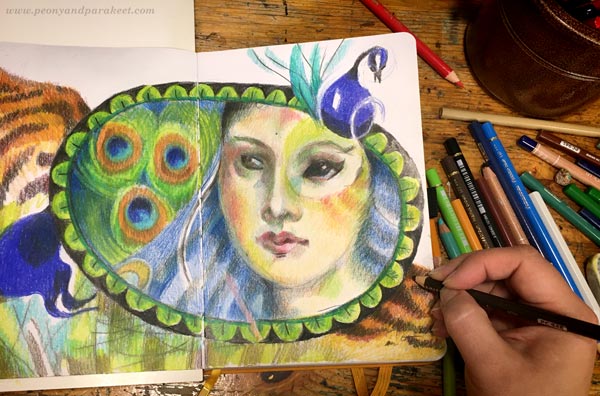
But when Stella got back from the hospital, I began to think that we will survive. That the peacock sometimes looks like a dove, and that the rest of us can just admire its flight through the youth.

But that would be another page for my colored pencil diary!

P.S. For more colored pencil inspiration, remember to sign up for Intuitive Coloring!